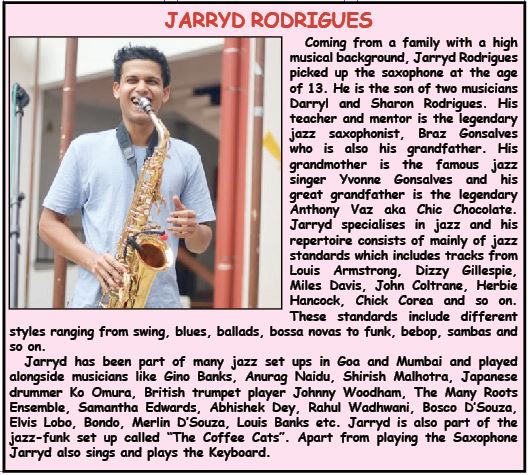PIONEER: Tito’s, which was originally a shack, soon converted into the state’s most famous nightclub. Tito’s became sound proof, as it grew bigger and bigger it also took care to insulate itself well so that the loud music late into the night did not upset the locals around.
Chief Minister Pramod Sawant is committed to Goa becoming the tourism capital of India. Besides the beaches and the casinos Goa is already a favorite of the bold and the beautiful, the rich and the powerful, for the extravagant musical night life that Goa offers to all music lovers.
By Rajan Narayan
During the Portuguese colonial regime there were schools but they were Portuguese language Lyceum schools up to the 10th standard. There were no Industrial Training Institutes (ITI) to impart vocational skills ranging from welding to carpentry to plumbing to electricity. Only the rich Hindu and Christian families could study in the Portuguese medium schools. After that they had to go for further education to Dharwad or Bombay or even Portugal for higher studies.
Particularly in the rural areas young people had no options for acquiring skills to get jobs. However, the one option they had was to join the private shipping or cruise lines or merchant navy ships. The general belief and also fact was that from Goa come all the best “ABCD” (ayahs, butlers, cooks and drivers).
In such a grim scenario the real sparkle of light came from the music choirs of the churches of Goa. Every church and even chapel had a priest who was a music teacher or a musician in charge of the local village choir. For those who may not be familiar with Christianity every church has a choir well trained in singing the large collection of hymns (devotional songs) during the mass.
MUSICAL GOA
A LOT of young people used to join the choir to learn how to play a wide range of musical instruments from the guitar to the piano to saxophone to trumpet to drums. The Goan drum called ghumot enjoys a special status at musical celebrations and social soirees. There was music in most every Christian family and the training picked up at home resulted in members playing a variety of instruments which oftentimes became a real passport for jobs they could seeking.
Goa has very many prominent Goans who also run celebrated business houses but which were initially funded by the salaries the parents’ generation got for working as musicians in various parts of the country and the world over.
Jobs were readily available to young people with an ability to play a music instrument. Every army unit whether it was the British army which ruled India till 1947, or the Portuguese government not only in Goa but in their other colonies like Angola in Africa, had bands attached to them. The bands were created not just for providing employment to the people but also to raise the spirit of soldiers on duty.
Musicians were paid in gold coins and to cite one example, it were these gold coins which financed the establishment of the giant pharmaceutical company of the Cosme Mathias group of industries headed by the late Pascoal Menezes. They were the pioneers in consumer products and still makes Old Spice and Handplast (the company is called Carter Wallace). The gold coins which Pascoal’s father earned as a musician gave him the capital to set up the first pharmacy shop. It went on to grow into a biggest supermarket which sold everything from gramophone records, cosmetics to imitation jewelry. All Bollywood used to come to the Pascoal Menezes departmental store to buy cosmetic jewelry.
SWADESHI OBSESSION!
THOSE who were very interested in classical music like Rusi Modi, who was the managing director of Tata Steel, used to come to Pascoal to get records of classical music which were banned in India. Initially, post-independence, the first prime minister of India, Jawaharlal Nehru, was obsessed with the idea of “swadeshi” and did not allow even the import of Gillette blades or foreign beauty products.
The CMM empire was not the only business group which had its origins in church choirs. For some reason the islands of Divar and Chorao in the river Mandovi produced the best musicians. The roots of weighing machine king, Salvador Fernandes, also found his capital for business in the church choir. Salvador’s father was part of the band in the British Indian army based in Pune.
His father’s close friend and college colleague gave Goa one of its senior most hotel managers in the country. The father of Vincent Ramos, regional director of the Taj Group of Companies, was a colleague of Salvador’s father in the band of the Indian Army. The major source of employment for the graduates of the music choirs was the film industry in Bombay.
Before Goans started invading Bombay the growing film industry did not have any live orchestras. It did not have musicians who could play a gamut of musical instruments. It was Anthony Gonsalves who hailed from Goa who pioneered and introduced the concept of an orchestra, where several musicians playing different instruments, could make a song more interesting. Anthony Gonsalves was one of the first conductors of the Hindi cinema industry’s music orchestra. He was the guru of several music directors like Laxmikant Pyarelal. The song “My Name is Anthony Gonsalves” in the film “Amar, Akbar, Anthony” produced by producer Manmohan Desai and featuring Amitabh Bachchan was dedicated to Anthony Gonsalves.
It took Goa many years and active campaigning by Goan Observer for Anthony Gonsalves to get recognition with an award for lifetime contribution at the International Film Festival of India in 2005. Legendary Goan saxophonist Braz Gonsalves was the star of the Hindi film industry. Braz was a wizard with the xaxophone. In his 80s, Braz Gonsalves still plays the saxophone, though he now plays devotional music. Braz Gonsalves along with his grandson Jarryd Rodrigues are scheduled to perform a series of concerts in Portugal next month.
And who can forget the Chris Perry and Lorna combination? Chris Perry was already a major vocalist and band leader in Mumbai. It was Chris Perry who spotted and guided the talent of Lorna in singing. For Goans, Lorna is the Lata Mangeshkar. Even at the age of 60 years plus, plus Lorna’s concerts are a sell-out today. The other musicians who inherited Goa’s music tradition is Remo Fernandes. Remo was an architect who switched to composing his own songs which were very critical of the government. I first remembered listening to Remo in the early 80s at the MPT seminary where Rajiv Gandhi, the then prime minister of India, was the chief guest. I even recall the lyrics “Please Mr PM, please come again to Goa.” So that the roads will get repaired.
Remo was nervous about whether Rajiv Gandhi would object to his song. He was in seventh heaven when Rajiv Gandhi personally wrote a letter to him saying how much he enjoyed his music and song. In the next generation of musicians you have Hema Sardessai, who can sing in several languages, including Hindi. Hema has sung for Hindi films. Tragically, she lost her husband Xavier D’Souza. Amongst the younger musicians who started singing at the age of 10 years is Akshata Bandekar, the daughter of the current dean of the GMC SM Bandekar.
Among the brightest stars to have had initial training at the Kala Academy music school was Anvita Shankar, one of the top sitar players in the country. At the age of 21 Anvita had the privilege of playing with Anushka Shankar, the daughter of the sitar legend Pandit Ravi Shankar.

TRANCE MUSIC KILLS
GOANS passing out of choirs also contributed to the night life of not only Mumbai, but even cities like Kolkata. There were many restaurants in Mumbai and Kolkata where Goan bands played live music. Unfortunately, the tradition of live music is dying out slowly, or is it reviving? The lively Goan music scene is being overtaken and killed by trance parties which sponsor taped high pitched music with a mind-blowing hypnotic quality, it was brought to Goa by the early hippies who smoked marijuana peacefully while living in coastal villages.
What distinguishes Electronic Dance Music (EDM) from live music? The answer is EDM is not live singing but music produced by DJs managing and mixing music from electronic turntables. For those who may not be aware of DJs, they are talented young musicians who use a blade on a gramophone recording on a turntable which in turn produces fusion sounds to make listeners deaf, dumb and zonked.
Such high decibel music is a matter of concern because DJ-created music is played at very high volume and the DJs can play all night and all day. Festivals like Sunburn are based not on live music but on electronic wizardry. Over the years with the active encouragement of local MLAs the beach hotspots of Anjuna, Vagator, Morjim and Mandrem, have emerged as main hubs for EDM music festivals.
Domestic tourists too now come in much larger numbers to get their minds blown off by EDM music. Like a young lady who posted on Facebook that she wanted to enjoy the nightlife of Goa from Friday to Monday and will someone guide her the best place to buy a house from where she can get easy access to the nightlife.
The domestic tourists who come to the beaches are not half as dangerous to Goa as the EDM tourists. The domestic tourists may cart around crates of beer and other liquor to get drunk on the beaches. But the EDM music venues like Hilltop and Hammerz and of course Tito’s, are not only favorite trance music venues but places which promote the trading of narcotics.
CHANGING GOA
GOA is the headquarters of the drug mafia with Israelis and Russians controlling the drug trade along with the Nigerians who are the main suppliers. Unfortunately, with an increasing number of Goans becoming drug addicts, they too have become part of the drug business. I would say let the domestic tourist drink on the beaches if they must. It is far more important to stop the night clubs promoting Goa’s huge and flourishing drug trade which is now a volatile cocktail of emerging casino lifestyles with capital city Panaji becoming a hub of unsavory tourism which may make cash registers ring but degrades and degenerates Goa from a tourist paradise into a sleaze tourism paradise where crime and trafficking in women thrives.
